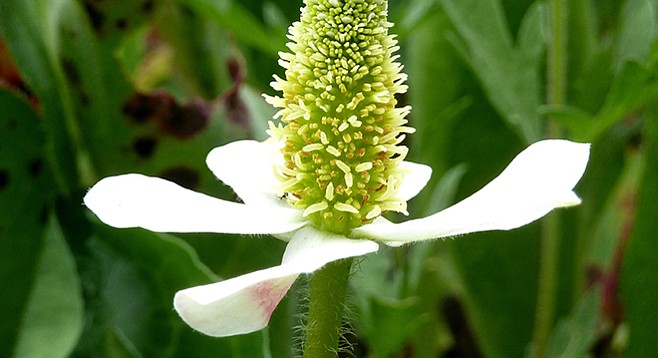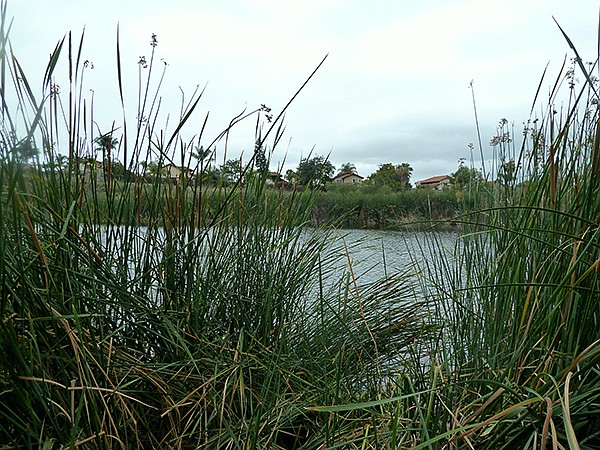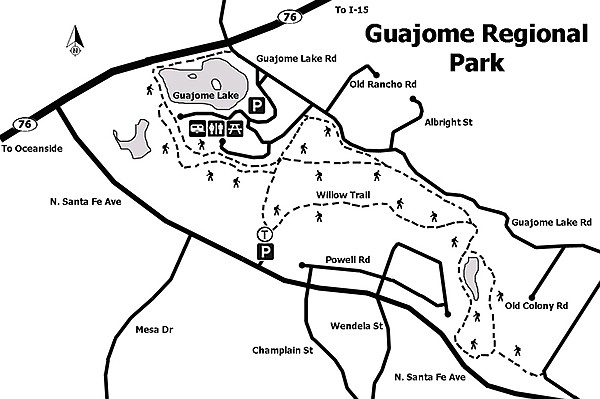 Facebook
Facebook
 X
X
 Instagram
Instagram
 TikTok
TikTok
 Youtube
Youtube

The name Guajome is taken from the Luiseño word “wakhavumi,” which means “frog pond.” Yes, it is that and so much more! Located just a breeze away from Carlsbad’s lagoons and the Pacific Ocean, this park offers a taste of some of San Diego County’s most favorite habitats: woodlands, chaparral, grasslands, and riparian wetlands, including two small ponds that attract migratory birds. In the summer, when most inland areas are arid and dry, cooling ocean breezes whisper through the trees. On weekday mornings, it has a secluded feel because most use is concentrated at the playground, picnic area, and adjacent campground. Guajome was once part of a Mexican land grant called Rancho Guajome. The ranch house is southeast of the park on Santa Fe Avenue and is a National Historic Landmark.

Start the hike at the main entrance, or else walk briefly along the sidewalk to another entrance at the night exit gate. The main hiking/biking trail circles 25-acre Guajome Lake and a shady gazebo, and the westernmost trail edges a willow-lined freshwater marsh with beckoning cottonwoods and mysterious cattails. Signs point toward a steeper trail to the upper pond, which offers a small fishing hole.
The park is a fascinating place for birdwatching. Over 150 species visit, and many stay year-round. Cassin’s kingbirds often winter here, and you may see San Diego’s top bird predator, the golden eagle. Observed species include grebes, great blue herons, turkey vultures, goldfinches, sapsuckers, ducks, hawks, American kestrels, merlins, California quails, owls, gulls, hummingbirds, flycatchers, vireos, bluebirds, wrens, sparrows, and warblers.
Listen for the sociable, grey northern mockingbird (Mimus polyglottos), which has white wing patches and white outer tail feathers. You will hear it mimic other birds, car alarms, lawnmowers, etc. and even your whistles and chirps until it gets bored and flies away. Each call is repeated, often in a series of three, before it moves on to the next. Males can learn up to 200 calls, and in the spring females are attracted to mates with the largest vocabulary.
You may also hear the sparkling trill of the western meadowlark (Sturnella neglecta), which nests on the ground in dense grass or other low vegetation. It also forages on the ground, preferably in San Diego’s remaining large tracts of grassland. This robin-size bird with a dark “V” on his bright yellow chest is especially vulnerable to urbanization because it cannot adapt to replacement of native plants by foreign weeds. San Diego has more biodiversity than any other county in the continental U.S, but it is also among the most threatened due to development and population growth.
The park boasts at least 50 native-plant species, as well as invasive and/or nonnative species. A showy, moderately invasive plant is the artichoke thistle (Cynara cardunculus), also called “cardoon.” It is easy to identify because the five-foot-high plants dominate some park areas with purple flowerheads as big as your hand. A highly invasive plant is the tamarisk, also called “saltcedar” (Tamarix ramosissima). Originally planted for shade and wind-breaks, the branches are airy with delicate pink flowers and small, scale-like leaves, which often have salt crystals on them. Individuals can produce 500,000 tiny seeds per year and cause drastic environmental impacts. Tamarisks lower the water table, which limits native plant and wildlife diversity because less water is available. It traps alluvial sediments that cause stream channels to narrow and flood more frequently and also increases fire frequency.
There are many hidden treasures here for native-plant lovers. Even in early June when summer is ready to begin, you can discover sacapellote (Acourtia microcephala) still clothed in bristly purple flowers with its large heart-shaped leaves sticky with resin; white sage (Salvia apiana), which was traditionally used by local Native Americans for respiratory problems and spiritual cleansing; salt heliotrope (Heliotropium curvassicum) with its five-pointed stars; Pacific pickleweed (Salicornia pacifica) that was used as a salty “sea bean”; and cheerful yellow coyote melon (Cucurbita foetidissima) in full bloom. Native American and Mexican tribes ate the seeds, used the gourds for ceremonial rattles, and used other parts in cosmetics, detergents, and insecticides.

At the marsh, look for the curious-looking yerba mansa (Anemopsis californica). The botanical name is from two Greek words that mean “like an anemone.” The white “petals” at the base of the flower are actually bracts (modified leaves). Noticeable are watercress, cattails, and bulrush at the ponds, which usually mark the edges of important hunting and fishing areas for animals and humans alike. Look and listen for croaking frogs, warily basking lizards, muddy salamanders, and dragonfly acrobats that dart in the sun as they hold their wings flat, away from their bodies.
Staying on designated trails will help avoid several “dangerous” plants in the park, such as poison oak, stinging nettle, castor bean, poison hemlock, and jimson weed. This will also help prevent habitat destruction. Never touch, pick, or eat these plants or any plant that you cannot positively identify.

Directions from downtown San Diego: 47 miles. Allow 52 minutes driving time (Oceanside). Take I-5 N and exit on SR-76 E. Drive east 7 miles on SR-76 E and turn right (southeast) on Guajome Lake Rd. The park entrance is just ahead. Pay day-use fee.
Hiking length: 4 miles of multi-use looping trails.
Difficulty: Moderate. Elevation gain/loss less than 100 feet. Trails are well-marked. Designated trails for hiking, bicycling, and equestrian use. Dogs (on leashes) allowed. Facilities and water. Picnic tables, fishing, and campground. Open: 9:30 a.m. to sunset.


The name Guajome is taken from the Luiseño word “wakhavumi,” which means “frog pond.” Yes, it is that and so much more! Located just a breeze away from Carlsbad’s lagoons and the Pacific Ocean, this park offers a taste of some of San Diego County’s most favorite habitats: woodlands, chaparral, grasslands, and riparian wetlands, including two small ponds that attract migratory birds. In the summer, when most inland areas are arid and dry, cooling ocean breezes whisper through the trees. On weekday mornings, it has a secluded feel because most use is concentrated at the playground, picnic area, and adjacent campground. Guajome was once part of a Mexican land grant called Rancho Guajome. The ranch house is southeast of the park on Santa Fe Avenue and is a National Historic Landmark.

Start the hike at the main entrance, or else walk briefly along the sidewalk to another entrance at the night exit gate. The main hiking/biking trail circles 25-acre Guajome Lake and a shady gazebo, and the westernmost trail edges a willow-lined freshwater marsh with beckoning cottonwoods and mysterious cattails. Signs point toward a steeper trail to the upper pond, which offers a small fishing hole.
The park is a fascinating place for birdwatching. Over 150 species visit, and many stay year-round. Cassin’s kingbirds often winter here, and you may see San Diego’s top bird predator, the golden eagle. Observed species include grebes, great blue herons, turkey vultures, goldfinches, sapsuckers, ducks, hawks, American kestrels, merlins, California quails, owls, gulls, hummingbirds, flycatchers, vireos, bluebirds, wrens, sparrows, and warblers.
Listen for the sociable, grey northern mockingbird (Mimus polyglottos), which has white wing patches and white outer tail feathers. You will hear it mimic other birds, car alarms, lawnmowers, etc. and even your whistles and chirps until it gets bored and flies away. Each call is repeated, often in a series of three, before it moves on to the next. Males can learn up to 200 calls, and in the spring females are attracted to mates with the largest vocabulary.
You may also hear the sparkling trill of the western meadowlark (Sturnella neglecta), which nests on the ground in dense grass or other low vegetation. It also forages on the ground, preferably in San Diego’s remaining large tracts of grassland. This robin-size bird with a dark “V” on his bright yellow chest is especially vulnerable to urbanization because it cannot adapt to replacement of native plants by foreign weeds. San Diego has more biodiversity than any other county in the continental U.S, but it is also among the most threatened due to development and population growth.
The park boasts at least 50 native-plant species, as well as invasive and/or nonnative species. A showy, moderately invasive plant is the artichoke thistle (Cynara cardunculus), also called “cardoon.” It is easy to identify because the five-foot-high plants dominate some park areas with purple flowerheads as big as your hand. A highly invasive plant is the tamarisk, also called “saltcedar” (Tamarix ramosissima). Originally planted for shade and wind-breaks, the branches are airy with delicate pink flowers and small, scale-like leaves, which often have salt crystals on them. Individuals can produce 500,000 tiny seeds per year and cause drastic environmental impacts. Tamarisks lower the water table, which limits native plant and wildlife diversity because less water is available. It traps alluvial sediments that cause stream channels to narrow and flood more frequently and also increases fire frequency.
There are many hidden treasures here for native-plant lovers. Even in early June when summer is ready to begin, you can discover sacapellote (Acourtia microcephala) still clothed in bristly purple flowers with its large heart-shaped leaves sticky with resin; white sage (Salvia apiana), which was traditionally used by local Native Americans for respiratory problems and spiritual cleansing; salt heliotrope (Heliotropium curvassicum) with its five-pointed stars; Pacific pickleweed (Salicornia pacifica) that was used as a salty “sea bean”; and cheerful yellow coyote melon (Cucurbita foetidissima) in full bloom. Native American and Mexican tribes ate the seeds, used the gourds for ceremonial rattles, and used other parts in cosmetics, detergents, and insecticides.

At the marsh, look for the curious-looking yerba mansa (Anemopsis californica). The botanical name is from two Greek words that mean “like an anemone.” The white “petals” at the base of the flower are actually bracts (modified leaves). Noticeable are watercress, cattails, and bulrush at the ponds, which usually mark the edges of important hunting and fishing areas for animals and humans alike. Look and listen for croaking frogs, warily basking lizards, muddy salamanders, and dragonfly acrobats that dart in the sun as they hold their wings flat, away from their bodies.
Staying on designated trails will help avoid several “dangerous” plants in the park, such as poison oak, stinging nettle, castor bean, poison hemlock, and jimson weed. This will also help prevent habitat destruction. Never touch, pick, or eat these plants or any plant that you cannot positively identify.

Directions from downtown San Diego: 47 miles. Allow 52 minutes driving time (Oceanside). Take I-5 N and exit on SR-76 E. Drive east 7 miles on SR-76 E and turn right (southeast) on Guajome Lake Rd. The park entrance is just ahead. Pay day-use fee.
Hiking length: 4 miles of multi-use looping trails.
Difficulty: Moderate. Elevation gain/loss less than 100 feet. Trails are well-marked. Designated trails for hiking, bicycling, and equestrian use. Dogs (on leashes) allowed. Facilities and water. Picnic tables, fishing, and campground. Open: 9:30 a.m. to sunset.
Comments